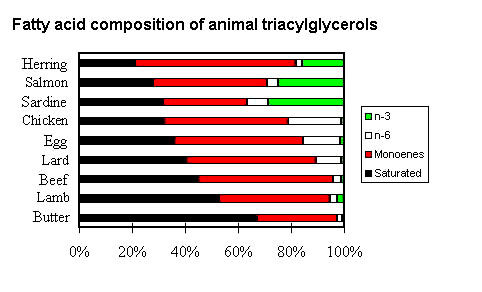
ANIMAL FATS
Animal fats can be found in various products such as by-products of meat (carcass fat of cattle and pigs, tallow, lard), by-products of fish caught (fish oil), milk (milk fat, butter fat) and accessorily poultry and eggs. In contrast with oil plants no livestock is bred particularly for fat production.
The next figure shows the gross fatty acid composition of purified triacylglycerols from some animal sources used in the human consumption.

It can be seen that butter and lamb fats are very saturated (more than 50% saturated fatty acids). Among land animals, only eggs and chicken fats have a consistent amount of essential fatty acids, aquatic sources being the richest. Herring, salmon and sardine are precious dietary sources of (n-3) polyunsaturated fatty acids (20:5 and 22:6).
In comparison with most vegetal oils, the animal fats are much more saturated and contain a relatively narrow range of fatty acids. An exception would be the ruminant milk fats, which contain large proportions of short chain fatty acids.
In contrast with plants where lipids are stored in seeds or fruits, in animals, fats are found everywhere. They are more abundant in adipose cells which are found either in concentrated location (subcutaneous, intraperitoneal) or infiltrated among muscle cells and are present in high concentration in bones. In contrast with plants, fatty acids with odd carbon numbers or with branched chains are found in animal fats, but in small amounts. These fats have also an important content in monounsaturated fatty acids.
Monoacetyldiglycerides (or acetodiacylglycerols) were detected in butter by TLC, the presence of acetate in these molecules being certified by GLC and infrared spectroscopy (Parodi PW, J Chromatogr 1975, 111, 223). These compounds were detected on TLC plates run in a solvent system without acid (hexane/ethyl acetate, 88/12) as a light spot between cholesterol and triglycerides.
Recently, the structure of the monoacetyldiglycerides present in an animal tissue, bovine udder, has been reported (Limb JK et al., J Lipid Res 1999, 40, 2169). These molecules, identified by NMR and mass spectrometry, contain acetic acid at the sn-3 position and various long-chain fatty acids at the two other positions (12:0, 14:0, 16:0, 18:0, 16:1, 18:1, 18:2) in various combinations. Similar compounds were previously described in vegetals.
Commercially important fats are produced from land animals (pork, beef, lamb, horse, poultry) but also from marine fish (fish oil from herring or menhaden).
![]()
LIPIDS OF LAND ANIMALS
MARINE LIPIDS
MILK FATS
MARGARINE
DISPERSIVE LIQUID-LIQUID MICROEXTRACTION
Lire la suiteDevenez membre et participez au développement de la Lipidomique au XXIème siècle.
S'inscrire